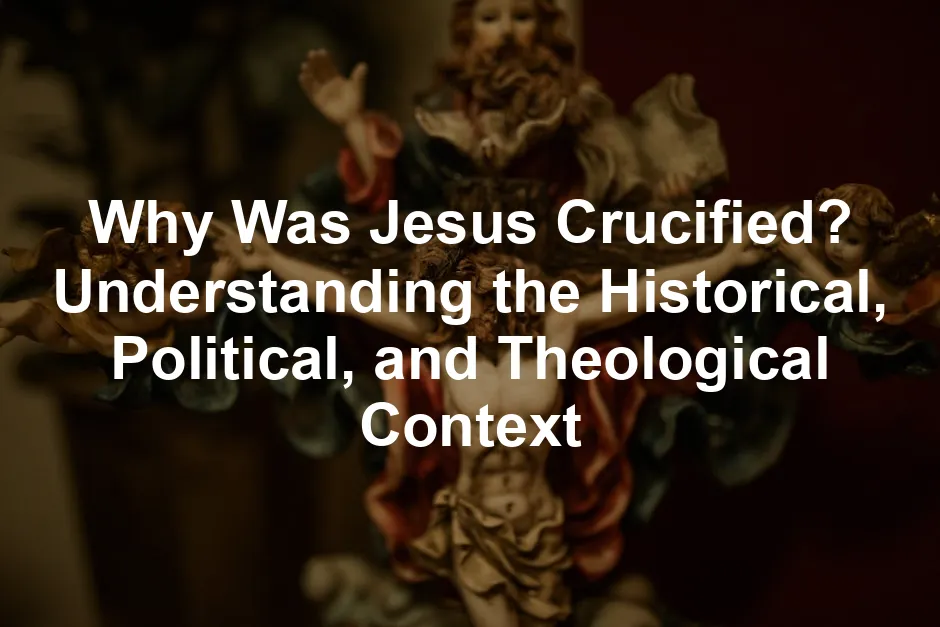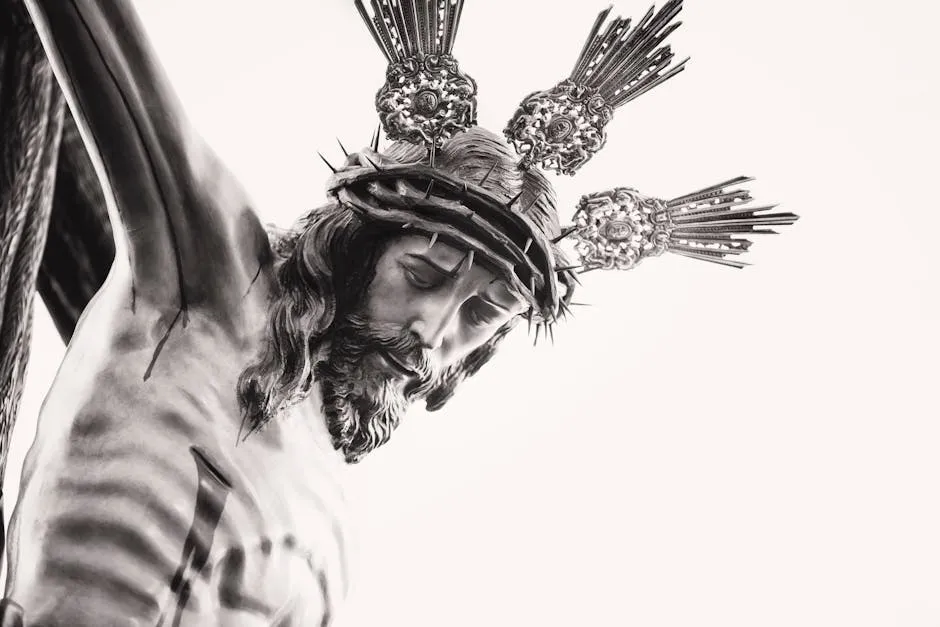
Why Was Jesus Crucified? Understanding the Historical, Political, and Theological Context
Introduction
Jesus’ crucifixion is central to Christianity. It signifies sacrifice and redemption. Various perspectives exist on why he faced this fate. This article examines the historical, political, and theological reasons behind his crucifixion. If you’re intrigued by this pivotal moment, you might enjoy “The Case for Christ” by Lee Strobel. This book dives deep into the evidence surrounding Jesus’ life and death, making it a must-read for anyone curious about these historical events.
Summary and Overview
The crucifixion of Jesus occurred in the 1st century, primarily noted in the Gospels. It reflects a complex interplay of historical events and theological implications. Understanding both earthly and divine reasons for this event is crucial. On one hand, Jesus challenged the Jewish authorities and Roman power. On the other, his death is seen as a divine plan for humanity’s salvation. Christian theology emphasizes his crucifixion as an atonement for sin, while historical accounts highlight political motivations. This duality enriches our comprehension of the event and its lasting significance.

To grasp the depth of these theological implications, consider reading “The Death of Jesus: Understanding the Last Seven Words from the Cross” by Fleming Rutledge. This insightful work explores the theological depth of Jesus’ final words and their significance.
Historical Context of Jesus’ Crucifixion
The Roman Rule in Judea
In the 1st century, Judea was under Roman control, creating a tense political climate. Roman governance enforced laws and maintained order, often clashing with local customs. Pontius Pilate served as the Roman governor. His relationship with Jewish leaders was complex, marked by mutual suspicion. Jewish authorities sought to maintain their power and appease the Romans. During Passover, a time of heightened tension, the presence of large crowds made the situation even more volatile. Any perceived threat to Roman authority could lead to severe consequences. Thus, the crucifixion of Jesus occurred against this backdrop of political unrest and fear.

Jesus’ Ministry and Growing Popularity
Jesus began his public ministry around the age of thirty. His teachings emphasized love, forgiveness, and the kingdom of God. This resonated deeply with many, drawing large crowds. People were captivated by his healing miracles and profound parables. As a result, his popularity soared.
However, this rise caught the attention of religious authorities. Jesus’ claims, particularly about being the Son of God, challenged their established beliefs. He openly criticized the Pharisees and their interpretations of the law, which angered them. His actions in the temple, like overturning money changers’ tables, further provoked their ire.
Jewish leaders feared Jesus could incite unrest. The Passover festival drew many visitors to Jerusalem. They worried that his influence could lead to a revolt against Roman rule. Maintaining order was crucial, as any disruption could result in harsh repercussions. Thus, Jesus’ growing popularity became a significant concern for those in power. If you’re interested in exploring more about the historical Jesus, check out “The Historical Jesus: Ancient Evidence for the Life of Christ” by Gary Habermas. It’s a fascinating read that delves into the evidence surrounding Jesus’ life.
The Immediate Causes of the Crucifixion
Arrest and Trial
The events leading to Jesus’ arrest unfolded rapidly. Judas Iscariot, one of his disciples, betrayed him for thirty pieces of silver. This act of treachery led to Jesus being captured in the Garden of Gethsemane. The Sanhedrin, the Jewish council, held a secret trial at night. They charged Jesus with blasphemy for claiming to be the Messiah.
During his trial, the high priest questioned him directly. Jesus affirmed his identity, leading to accusations of blasphemy. The charges were serious, as they attacked the core of Jewish belief. Additionally, claiming kingship posed a direct challenge to Roman authority, which made the case even more alarming.
These charges had profound implications. Blasphemy was punishable by death under Jewish law. However, since the Romans controlled Judea, capital punishment required their approval. Thus, the trial became a pivotal moment, setting the stage for his crucifixion. For further insights, consider “The Cross of Christ” by John Stott. It provides a compelling theological exploration of the significance of the cross in Christian faith.
Role of Pontius Pilate
Pontius Pilate played a crucial role in the crucifixion of Jesus. As the Roman governor, he initially hesitated to condemn Jesus. Pilate found no fault in him, believing he was innocent. However, political pressure mounted from the Jewish leaders and the crowd demanding Jesus’ execution.

The situation escalated during the Passover festival. Pilate faced the risk of unrest if he did not act. The crowd’s insistence on crucifixion forced his hand. To absolve himself of responsibility, Pilate famously washed his hands before the crowd, declaring himself innocent of Jesus’ blood.
Despite his reluctance, Pilate ultimately authorized the crucifixion. This act demonstrated the complex interplay of local politics and Roman authority. His actions would have lasting implications, intertwining Jesus’ fate with the power struggles of the time. If you’re curious about the cultural ramifications of Jesus’ death, check out “Crucifixion: Understanding the Death of Jesus” (DVD) to gain a deeper understanding of this pivotal event.
Theological Interpretations of the Crucifixion
The Significance of the Atonement
Jesus’ crucifixion is central to Christian theology. Many believe it was an atonement for humanity’s sins. This concept is rooted in the idea that Jesus, as the Lamb of God, took on the sins of the world. John 1:29 states, “Behold, the Lamb of God, who takes away the sin of the world!” This emphasizes that Jesus’ death was not just an event but a divine purpose for redemption.
Additionally, Romans 3:25-26 supports this view. It states, “God presented Christ as a sacrifice of atonement, through the shedding of his blood.” This reinforces the belief that Jesus’ death was essential for humanity’s reconciliation with God. For Christians, the crucifixion represents hope and the promise of eternal life. It signifies that through faith in Jesus, anyone can find forgiveness and restoration in their relationship with God. To explore this atonement concept more, consider “The Resurrection of the Son of God” by N. T. Wright, which delves into the implications of the resurrection.

Fulfillment of Prophecy
The crucifixion of Jesus also fulfills numerous Old Testament prophecies. For Christians, these prophecies are seen as a divine plan coming to fruition. Isaiah 53 is often cited, portraying the suffering servant who bears the iniquities of many. This chapter vividly describes the suffering and sacrifice that Jesus would endure.
From a Jewish perspective, interpretations vary. Some acknowledge the prophetic texts but see them as metaphorical rather than literal predictions of Jesus. The differences highlight the complex relationship between Jewish and Christian interpretations of scripture. Nevertheless, both perspectives recognize the significance of prophecy in understanding the crucifixion’s place in history. To further your exploration, consider “The Passion Narratives in the Four Gospels” by William L. Lane. This book offers a detailed examination of the passion narratives and their theological implications.
The Cultural and Historical Ramifications
Impact on Early Christianity
The crucifixion profoundly shaped early Christian beliefs and practices. After Jesus’ death, his followers began to spread his teachings. They emphasized the significance of the resurrection, which served as a cornerstone of Christian faith. The resurrection reassured believers that death was not the end, but the beginning of eternal life.

Early Christians gathered to remember Jesus’ sacrifice. They celebrated the Eucharist as a way to honor his body and blood. This practice became integral to Christian worship, symbolizing unity with Christ. The crucifixion also instilled a sense of mission. Early Christians felt compelled to share the message of salvation with others. To deepen your understanding of the early church, you might find “A Short History of Christianity” by Geoffrey Blainey enlightening.
Modern Interpretations and Misunderstandings
In today’s world, interpretations of Jesus’ crucifixion vary widely across different religions. For Christians, it’s a profound act of sacrifice for humanity’s sins. Many see it as a pivotal moment in the story of redemption. In contrast, Jewish perspectives often focus on the political motivations behind the crucifixion. The Jewish leaders viewed Jesus as a threat to their authority and the stability of their society.
Islamic traditions assert that Jesus was not crucified but rather that it appeared so to his enemies. This view diverges significantly from Christian beliefs and highlights ongoing theological debates. Additionally, misconceptions abound regarding why Jesus faced crucifixion. Some people mistakenly think he was executed merely for being kind or inclusive. However, the reality is more complex. Jesus was seen as a challenge to both religious and political authorities. His claims of divinity were perceived as blasphemous, leading to his condemnation. Understanding these modern interpretations helps clarify the significance of this historical event.
Conclusion
The reasons for Jesus’ crucifixion intertwine historical, political, and theological factors. His execution stemmed from a combination of social unrest and religious challenges. Recognizing these aspects deepens our understanding of this pivotal moment in history. It also highlights the diverse views surrounding Jesus’ death, shaping beliefs across cultures. Delving into this topic offers valuable insights into the foundations of Christianity and its enduring influence. If you’re curious for more, consider exploring additional resources to gain a broader perspective on this critical event. You might find The Bible editions to be essential for a deeper understanding of the scripture that narrates these events.
How do different religions view the crucifixion of Jesus?
The crucifixion of Jesus has different interpretations across religions. In Christianity, it’s viewed as the ultimate sacrifice for humanity’s sins. Jesus’ death is central to Christian theology, emphasizing redemption and atonement. The resurrection that follows is seen as a triumph over death.
Judaism, however, perceives Jesus differently. Jewish beliefs do not recognize Jesus as the Messiah. The focus is on the historical context of his execution, viewing it as a result of political and religious tensions. Many Jewish teachings highlight the role of Jewish authorities in his death, but do not see it as a divine act of salvation.
Islam presents yet another perspective. The Quran states that Jesus was not crucified; rather, it appeared so to others. This view maintains Jesus’ prophethood while denying his execution. Muslims respect Jesus as a significant figure but reject the notion of his death as a sacrificial atonement.
Understanding these varied viewpoints enriches the dialogue about Jesus’ crucifixion and its significance in different faiths. For those interested in exploring more about the implications of these interpretations, consider “The Meaning of Jesus: Two Visions” by Marcus J. Borg and N. T. Wright. This book presents contrasting views on Jesus’ life and mission.
What are some common misconceptions about Jesus’ death?
Many misconceptions surround Jesus’ crucifixion. A common belief is that he was executed solely for being kind or inclusive. In reality, his claims of divinity and challenges to religious authority were significant factors leading to his death.
Another misconception is that the Jewish people as a whole are responsible for his crucifixion. In truth, it was a complex interplay of political motivations involving both Jewish leaders and Roman authorities. This narrative has often fueled anti-Semitic sentiments, which is unjust.
Additionally, some think that Jesus was a revolutionary seeking political power. While he did challenge the status quo, his teachings focused on spiritual transformation rather than political insurrection. Recognizing these misconceptions helps clarify the historical and theological context of Jesus’ crucifixion. If you’re looking for a concise guide to these themes, consider “The Crucifixion: Understanding the Death of Jesus” (booklet), a quick read that addresses these important topics.
How did the crucifixion influence early Christian thought?
The crucifixion of Jesus profoundly influenced early Christian thought. It became the cornerstone of Christian belief, symbolizing sacrifice and redemption. Early Christians viewed Jesus’ death as essential for atonement, laying the groundwork for the doctrine of salvation.
The resurrection, following the crucifixion, was pivotal in shaping early church beliefs. It provided hope and assurance of eternal life, encouraging believers to spread Jesus’ teachings. The message of resurrection transformed the perception of death, presenting it as a transition rather than an end.
Moreover, the crucifixion inspired early Christian practices. The Eucharist, or communion, emerged as a way to remember Jesus’ sacrifice. This ritual became central to Christian worship, fostering a sense of community among believers. Overall, the crucifixion not only shaped theological perspectives but also influenced the formation of early Christian identity and community practices. If you’re curious about the broader implications of these themes, consider “The Cross: A History” by David L. Edwards. This book offers a fascinating exploration of the historical significance of the cross in Christianity.
Please let us know what you think about our content by leaving a comment down below!
Thank you for reading till here 🙂
All images from Pexels




